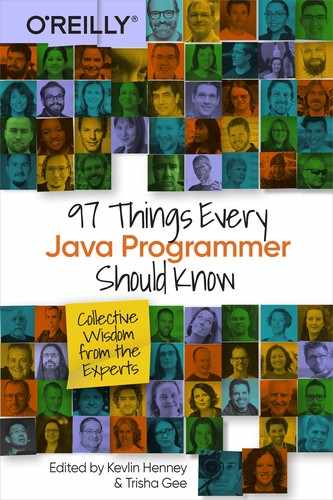Chapter 25. Follow the Boring Standards
Adam Bien

At the beginning of the Java age, there were dozens of incompatible application servers on the market, and the server vendors followed completely different paradigms. Some servers were even partially implemented in native languages like C++. Understanding multiple servers was hard, and porting an application from one server to another was nearly impossible.
APIs like JDBC (introduced with JDK 1.1), JNDI (introduced with JDK 1.3), JMS, JPA, or Servlets abstracted, simplified, and unified already established products. EJBs and CDI made the deployment and programming models vendor agnostic. J2EE, later Java EE and now Jakarta EE, and MicroProfile defined a minimal set of APIs an application server had to implement. With the advent of J2EE, a developer only had to know a set of J2EE APIs to develop and deploy an application.
Although the servers evolved, the J2EE and Java EE APIs remained compatible. You never had to migrate your application to run on a newer release of the application server. Even upgrading to a higher Java EE version was painless. You only had to re-test the application without even recompiling it. Only if you wanted to take advantage of newer APIs did you have to refactor the application. With the introduction of J2EE, developers could master multiple application servers without delving too deep into their specifics.
We have a very similar situation in the web/JavaScript ecosystem right now. Frameworks like jQuery, Backbone.js, AngularJS 1, Angular 2+ (completely different from AngularJS 1), ReactJS, Polymer, Vue.js, and Ember.js follow completely different conventions and paradigms. It has become hard to master multiple frameworks at the same time. The initial goal of many frameworks was to address incompatibility issues among different browsers. As browsers became surprisingly compatible, frameworks started to support data binding, unidirectional data flow, and even enterprise Java features like dependency injection.
At the same time, browsers became not only more compatible but also provided features previously available only with third-party frameworks. The function querySelector is available in all browsers and provides comparable functionality to jQuery’s DOM access capabilities. Web Components with Custom Elements, Shadow DOM, and Templates enable developers to define new elements containing UI and behavior, and even to structure entire applications. As of ECMAScript 6, JavaScript became more similar to Java, and ES6 modules made bundling optional. The MDN (Mozilla Developer’s Framework) became a unified effort from Google, Microsoft, Mozilla, W3C, and Samsung to provide a home for web standards.
Now it’s possible also to build frontends without frameworks. Browsers have an excellent track record for being backward compatible. All the frameworks have to use the browser APIs regardless, so by learning the standards you also understand the frameworks better. As long as browsers don’t introduce any breaking changes, just relying on web standards without any frameworks is enough to make your application last.
Focusing on standards allows you to gain knowledge incrementally over time—an efficient way to learn. Evaluating popular frameworks is exciting, but the gained knowledge isn’t necessarily applicable to the next “hot thing.”
